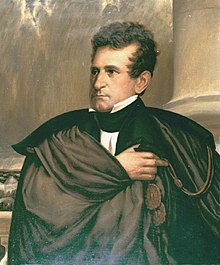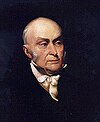Samuel L. Southard
Samuel Southard | |
|---|---|
 | |
| President pro tempore of the United States Senate | |
| In office March 11, 1841 – May 31, 1842 | |
| Preceded by | William R. King |
| Succeeded by | Willie Person Mangum |
| United States Senator from New Jersey | |
| In office March 4, 1833 – June 26, 1842 | |
| Preceded by | Mahlon Dickerson |
| Succeeded by | William L. Dayton |
| In office January 26, 1821 – March 3, 1823 | |
| Preceded by | James J. Wilson |
| Succeeded by | Joseph McIlvaine |
| 10th Governor of New Jersey | |
| In office October 26, 1832 – February 27, 1833 | |
| Preceded by | Peter Dumont Vroom |
| Succeeded by | Elias P. Seeley |
| 7th United States Secretary of the Navy | |
| In office September 16, 1823 – March 4, 1829 | |
| President | James Monroe John Quincy Adams |
| Preceded by | Smith Thompson |
| Succeeded by | John Branch |
| Personal details | |
| Born | Samuel Lewis Southard June 9, 1787 Basking Ridge, New Jersey, U.S. |
| Died | June 26, 1842 (aged 55) Fredericksburg, Virginia, U.S. |
| Political party | Democratic-Republican (Before 1825) National Republican (1825–1834) Whig (1834–1842) |
| Spouse(s) | Rebecca Harrow |
| Education | Princeton University (BA) |
Samuel Lewis Southard (June 9, 1787 – June 26, 1842) was a prominent U.S. statesman of the early 19th century, serving as a U.S. Senator, Secretary of the Navy, and the tenth governor of New Jersey. He also served as President pro tempore of the Senate, and was briefly first in the presidential line of succession.
History[]
The son of Henry Southard and Sarah (Lewis) Southard, was born in Basking Ridge, New Jersey on June 9, 1787.[1] Southard's ancestors included Anthony Janszoon van Salee, one of the earliest settlers of New Amsterdam, and his siblings included Isaac Southard.[2][3] Southard attended the Brick Academy[4] classical school and graduated from Princeton University in 1804.[1]
Early career[]
After teaching school in New Jersey, he worked for several years as a tutor in the Virginia home of John Taliaferro, his father's Congressional colleague.[1] While living in Virginia, Southard studied law with Francis T. Brooke and Judge Williams, both of Fredericksburg. Upon being admitted to the bar, he returned to New Jersey, where he was appointed law reporter by the New Jersey Legislature in 1814. Elected to the New Jersey General Assembly in 1815, Southard was appointed to the New Jersey Supreme Court to succeed Mahlon Dickerson shortly thereafter, and in 1820 served as a presidential elector. He was elected to a seat in the United States Senate over James J. Wilson, and was appointed to the remainder of Wilson's term After Wilson resigned.[5] Southard served in office from January 26, 1821 to March 3, 1823 when he resigned. During this time, he was a member of the committee that produced the Missouri Compromise.
[]
President James Monroe selected Senator Southard to be Secretary of the Navy in September 1823, and he remained in office under President John Quincy Adams.[1] During these years, he also served briefly as ad interim Secretary of the Treasury (1825) and Secretary of War (1828).[1] Southard proved to be one of the most effective of the Navy's early Secretaries. He endeavored to enlarge the Navy and improve its administration, purchased land for the first Naval Hospitals, began construction of the first Navy dry docks, undertook surveys of U.S. coastal waters and promoted exploration in the Pacific Ocean. Responding to actions by influential officers, including David Porter, he reinforced the American tradition of civilian control over the military establishment. Also on Southard's watch, the Navy grew by some 50% in personnel and expenditures and expanded its reach into waters that had not previously seen an American man-of-war.
Political life[]
In 1829 Southard became New Jersey Attorney General, succeeding Theodore Frelinghuysen.[1] In 1832, the state legislature elected him Governor over Peter D. Vroom by a vote of 40 to 24. In 1833, he was again elected to the U.S. Senate. During the next decade, he was a leader of the Whig Party and attained national prominence as chairman of the Committee on Naval Affairs. As President pro tempore of the Senate, he was first in the presidential line of succession after the death of William Henry Harrison and the accession of Vice President John Tyler to the presidency.
Failing health forced Southard to resign from the Senate in 1842. He died in Fredericksburg, Virginia on June 26, 1842. Southard was buried in Washington's Congressional Cemetery.
Societies[]
During the 1820s, Southard was a member of the prestigious society, Columbian Institute for the Promotion of Arts and Sciences, who counted among their members former presidents Andrew Jackson and John Quincy Adams and many prominent men of the day, including well-known representatives of the military, government service, medical and other professions.[6] In 1839, he was elected to the American Philosophical Society.[7]
Legacy[]
The destroyer USS Southard (DD-207), (later DMS-10), 1919–1946, was named in his honor. There is also a public park in Basking Ridge, New Jersey, named after him.
See also[]
References[]
- ^ Jump up to: a b c d e f Leinaweaver, Chad, ed. (2008). New Jersey Encyclopedia. 1 (2008-2009 ed.). Hamburg, MI: State History Publications. pp. 181–182. ISBN 978-1-8785-9244-6 – via Google Books.
- ^ De Halve Maen. 63–68. New York, NY: The Holland Society of New York. 1990. p. 4 – via Google Books.
- ^ GQ Press Guide to Congress. I (Seventh ed.). Los Angeles, CA: Sage Reference. 2013. p. 1613. ISBN 978-1-4522-3532-5 – via Google Books.
- ^ Lurie, Maxine N.; Mappen, Marc, eds. (2004). Encyclopedia of New Jersey. New Brunswick, NJ: Rutgers University Press. p. 61. ISBN 978-0-8135-3325-4 – via Google Books.
- ^ Birkner, Michael J. (1984). Samuel L. Southard: Jeffersonian Whig. Cranbury, NJ: Associated University Presses. p. 47-48. ISBN 978-0-8386-3160-7.
- ^ Rathbun, Richard (1904). The Columbian institute for the promotion of arts and sciences: A Washington Society of 1816-1838. Bulletin of the United States National Museum, October 18, 1917. Retrieved 2010-06-20.
- ^ "APS Member History". search.amphilsoc.org. Retrieved 2021-04-09.
Sources[]
 This article incorporates public domain material from websites or documents of the Naval History and Heritage Command.
This article incorporates public domain material from websites or documents of the Naval History and Heritage Command.- Dictionary of American Biography.
- Birkner, Michael. Samuel L. Southard: Jeffersonian Whig. Rutherford, N.J.: Fairleigh Dickinson University Press, 1984.
- Ershkowitz, Herbert. Samuel L. Southard: A Case Study of Whig Leadership in the Age of Jackson. 88 (Spring 1970): 5-24.
- Samuel L. Southard Papers (1783-1893),(bulk 1802-1846), Finding Aid C0250, consisting of 170 boxes and 73.6 lineal feet of original documents of financial and personal affairs, including correspondence from Charles Muir Campbell of Princeton, NJ. Most boxes are organized by year and subject. Access to these documents is Princeton University Library, Department of Rare Books and Special Collections, Manuscripts Division.
External links[]
- United States Congress. "Samuel L. Southard (id: S000689)". Biographical Directory of the United States Congress.
- New Jersey Governor Samuel Lewis Southard, National Governors Association
- Samuel Lewis Southard at The Political Graveyard
- Samuel L. Southard at Find a Grave
- 1787 births
- 1842 deaths
- People from Bernards Township, New Jersey
- American people of Dutch descent
- American Presbyterians
- United States Secretaries of the Navy
- Monroe administration cabinet members
- John Quincy Adams administration cabinet members
- Democratic-Republican Party United States senators from New Jersey
- National Republican Party United States senators from New Jersey
- Whig Party United States senators from New Jersey
- Presidents pro tempore of the United States Senate
- Governors of New Jersey
- National Republican Party state governors of the United States
- New Jersey Attorneys General
- Members of the New Jersey General Assembly
- Justices of the Supreme Court of New Jersey
- Politicians from Fredericksburg, Virginia
- Princeton University alumni
- Burials at the Congressional Cemetery







